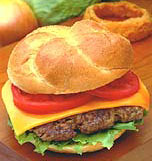 Fast food restaurants are feeding the obesity epidemic by tricking people into eating many more calories than they mean to, an important study has shown. Fast food restaurants are feeding the obesity epidemic by tricking people into eating many more calories than they mean to, an important study has shown.
Typical menus at McDonald's, KFC and Burger King contain 65 per cent more calories per bite than standard British meals, making it far too easy ffor customers to overindulge without realising it. The high "energy density" of junk food - the amount of calories it contains in relation to its weight - throws the brain's appetite control system into confusion, as this is based on the size of a portion rather than its energy content. The critical role of energy density in obesity has been revealed by Andrew Prentice, Professor of International Nutrition at the London School of Hygiene and Tropical Medicine, and Susan Jebb, of the Medical Research Council Human Nutrition Centre in Cambridge. In a study published in the journal Obesity Reviews, they calculated the average energy density of menus at McDonald's, KFC and Burger King, using nutritional data from the fast food chains' websites. The average energy density of these restaurants' meals was 263 calories per 100 grams, 65 per cent more than the density of the average British diet and more than twice that of a recommended healthy diet. This means that a person eating a Big Mac and fries would consume almost twice as many calories as someone eating the same weight of pasta and salad. Professor Prentice said that the human appetite encouraged people to eat a similar bulk of food, regardless of its calorific value. This left regular consumers of fast food prone to "accidental" obesity, in which they grew fat while eating portions they did not consider large. Professor Prentice added: "Since the dawn of agriculture, the systems regulating human appetites have evolved for the low-energy diet still consumed in rural areas of the developing world, where obesity is almost non-existent. Our system of appetite control is completely unpicked by the junk food diet." When fast food is eaten often, even small miscalculations of portion size can have major effects, the study found. If a person eats 200g extra of fast food with a density of 1,200kJ per 100g just twice a week, he would consume an extra 250,000kJ a year. This is enough to put on almost 8kg of fat. Fast food outlets should reduce the energy density of their menus as well as their portion sizes, the scientists said. (Agencies)
| 一項重要的研究顯示:快餐店引誘人們攝入的卡路里遠遠超過他們實際所需要的量,結(jié)果助長了肥胖病的流行。 麥當(dāng)勞、肯德基和漢堡王的代表食品每一口的卡路里含量都比普通的西餐高出65%,讓消費者們很容易就在不知不覺中攝入了過多的卡路里。 垃圾食品含有很高的“能量密度”,即食物重量和卡路里含量的比例。垃圾食品往往使大腦的食欲控制系統(tǒng)陷入混亂,因為控制系統(tǒng)判斷的標(biāo)準(zhǔn)是食物份量的大小而不是熱量含量的高低。 倫敦公共醫(yī)學(xué)與熱帶醫(yī)學(xué)學(xué)院的國際營養(yǎng)學(xué)教授安德魯·普倫蒂塞和劍橋大學(xué)醫(yī)學(xué)研究學(xué)會人類營養(yǎng)研究中心的蘇姍·杰布已經(jīng)揭示了能量密度在導(dǎo)致肥胖中的關(guān)鍵性作用。
《肥胖評論》雜志發(fā)表了他們的研究結(jié)果,他們通過快餐連鎖網(wǎng)站上的營養(yǎng)數(shù)據(jù)計算了麥當(dāng)勞、肯德基和漢堡王食品的平均能量密度。 這些快餐店食品的平均能量密度是每一百克263卡路里,比英國日常飲食的能量密度高出65%,是推薦的健康飲食能量密度的兩倍多。這意味著吃一個巨無霸和炸薯條所攝入的卡路里差不多是吃同樣重量的意大利面和色拉所攝入熱量的兩倍。 普倫蒂塞教授說人類的食欲誘使他們攝入相似體積的食物,而不顧食物的卡路里含量。這就使得那些經(jīng)常吃快餐的人在不經(jīng)意間就變胖了,而他們自己卻并沒覺得吃的特別多。 普倫蒂塞教授補充說:“從農(nóng)業(yè)產(chǎn)生以來,人類的食欲調(diào)節(jié)系統(tǒng)不斷向低能量進化。在發(fā)展中國家的農(nóng)村,人們飲食中熱量的含量還是很低的,在這些地方,肥胖病幾乎不存在。我們的食欲控制系統(tǒng)完全被垃圾食品搞亂了。”
研究發(fā)現(xiàn):如果你經(jīng)常吃快餐食品,即使份量上很小的差異都會造成很大的影響。如果一個人每周兩次多攝入200克能量密度為1200千焦/百克的快餐食品,他每年多攝入的熱量就會達到25萬千焦,這足以增加近8千克脂肪。 科學(xué)家們指出,快餐店不僅要降低食品的能量密度,而且要縮小食品的體積。
(中國日報網(wǎng)站譯)
|
